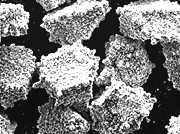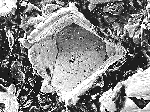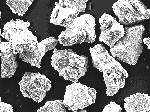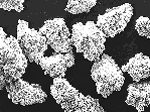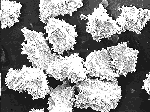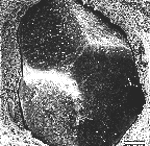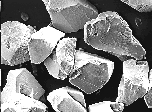Superabrasive coatings strengthen the bond between superabrasive crystals and the grinding-wheel matrix.
Superabrasives are renowned for their superior hardness, strength, abrasion resistance, and thermal conductivity over conventional abrasives. But one thing can render diamond and cubic boron nitride (CBN) powerless: a weak bond between the crystals and the matrix material. This bond should be strong enough to retain the crystals while they wear and resharpen themselves through fracture or attrition. Ideally, only after the superabrasive crystals have become too small to be effective should they be released and replaced by new crystals emerging from the bond.
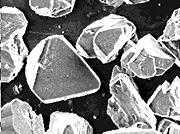
A
B |
| Figure 1: A comparison between uncoated (A) and nickel-coated (B) CBN crystals shows how superabrasive coatings add surface texture. |
Superabrasive coatings have become essential for optimizing bond systems in many grinding wheels and cutting tools. These metallic coatings or surface treatments are applied to diamond and CBN crystals before the crystals are combined with a bond material and formed into wheels and tools for grinding, honing, cutoff, drilling, and other applications where consistent tool geometry, free cutting capabilities, long tool life, and dissipation of heat from the tool/workpiece interface are important.
The strength with which the wheel matrix holds the superabrasive crystals affects the efficiency of any bond system. This bond strength can be undermined by the smooth surface of the crystals. One function of superabrasive coatings is to add texture to the surface of the diamond or CBN crystals (Figure 1). The textured surface allows the coated crystal to be held more aggressively in the bond through mechanical adhesion. This helps prevent the entire crystal and its coating from pulling out of the bond (Figure 2A). By increasing the retention strength of the crystals in the bond, the coating helps extend wheel life.
A superabrasive coating also provides a more rigid hold on the crystal than the matrix does. This helps prevent the bare crystal from pulling out of its coating shell (Figure 2B). In addition, the coating has a “wrapping” or “girdling” effect on the crystal. This reduces catastrophic fracture in which a crystal, which typically fractures just enough to expose a new cutting edge, shatters and is no longer usable.
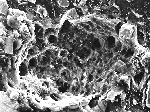
A
B |
| Figure 2: Superabrasive coatings’ hold on the matrix and crystal reduce the chance of crystal pullout from the bond (A) and from the coating shell (B). |
Although superabrasive coatings are most commonly used in resin- and metal-bond grinding wheels, special coatings or surface treatments enhance the performance of diamond and CBN in vitrified-bond and single-layer wheels as well.
Resin Bonds
Superabrasive coatings were first applied to manufactured industrial diamond in resin-bond grinding wheels. The first manufactured diamond, “Type A,” was introduced commercially in 1957 by General Electric. Type A performed as well as mined diamond in resin-bond wheels used for the manufacture and maintenance of hardened-steel and carbide cutting tools. However, Type A couldn’t withstand the high temperatures needed to manufacture metal- and vitrified-bond wheels. The diamond would either graphitize or lose fracture strength when the wheels were sintered.
The first industrial diamond products cost up to 10 times more (in 1957 dollars) than today’s diamond products. Driven by the desire to reduce these high costs, researchers tried to find ways to make expensive resin-bond diamond grinding wheels last longer. In the early 1960s, they discovered that certain coatings, applied to the surface of the diamond crystals, significantly reduced the wheel’s wear rate. By enhancing wetability, a measure of surface adsorption between the resin bond and the coating, these coatings helped retain the diamond crystals in the resin bond for a longer period of time, thus extending wheel life. The coatings also increased the crystals’ heat capacity. A diamond crystal coated with a thick layer of metal could absorb more heat energy than an uncoated crystal could, without a significant increase in temperature. This allowed the crystal to do more work, because the coating absorbed the excessive frictional heat at the crystal/workpiece interface. By improving heat dissipation from the crystal, the coating helped prevent thermal degradation of the surrounding resin matrix.
Researchers experimented with many coating types and application methods in their search for the most cost-effective superabrasive coating. The first coating to become commercially available was a thick layer of nickel. This coating provided a good holding surface around the diamond crystals in resin-bond grinding wheels, which primarily use phenolic or polyimide resins to hold and retain the crystals.
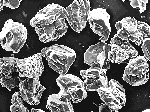
A
B
C
D |
| Figure 3: Various types of diamond used in resin bonds. The crystals are shown without coatings (A) and with nickel coatings with weight percentages of 30% (B), 56% (C), and 60% (D). |
Today, coatings are applied to both diamond and CBN crystals in resin-bond grinding wheels. These coatings are usually thick metallic coatings of nickel or copper. Nickel is more widely used, but copper is suitable for coating diamond crystals in resin-bond wheels for dry grinding and wet creep-feed grinding. These coatings typically comprise from 30% to 70% of the total weight of the coated crystal (Figure 3). For diamond crystals, the typical weight percentage is 56% for nickel and 50% for copper; for CBN crystals, it is 60% for nickel and 50% for copper. The coating thickness depends on the desired weight percentage and the mesh size of the crystal. For example, a larger crystal with a 60% weight percentage and a 60/80 mesh size would have a nickel coating 30µm thick.
Following nickel, coating developments have included materials such as titanium, molybdenum, chromium, cobalt, silver, iron, polymers, and ceramics. While nonmetallic coatings have not proven beneficial in resin-bond grinding wheels, other materials are quite valuable. For example, cobalt and silver coatings promote good bond adhesion and heat dissipation during grinding. Some metallic coatings, including nickel, copper, and silver, may provide a degree of lubrication in the grinding process to prevent chips from mechanically adhering to the resin bond.
Most of the factors that give superabrasive coatings the ability to enhance the performance of resin-bond grinding wheels also apply to coatings for metal-bond wheels.
Metal Bonds
Following resin bonds, metal bonds are the most common type of matrix used to hold coated superabrasive crystals. Metal bonds composed of bronze, cobalt, tungsten, or other metals are extremely tough, durable, and wear resistant. Diamond and CBN crystals in these bond materials must be blocky in shape and smooth in texture to resist impact fracture and withstand thermal degradation caused by the high process temperatures generated when the wheels are manufactured (Figure 4).
Despite the benefits of the blocky shape and smooth texture of this type of crystal, these design features make it extremely difficult to develop a strong bond between the crystal and the metal matrix. Consequently, a major wear mechanism of a metal bond is crystal pullout, or loss of the superabrasive crystal before it has been completely and effectively utilized. When researchers analyzed used segments of metal-bond diamond wheels, they generally found about one-third of the working crystal sites devoid of the crystal. This was a result of the crystal being pulled from the matrix. The researchers determined that reducing the number of pullout sites by increasing the strength of the crystal/matrix bond should extend overall wheel life.
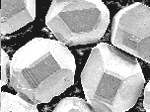 |
| Figure 4: One type of blocky diamond used in metal bonds. |
The inert chemical composition of CBN prevents it from reacting with metal bonds. A titanium layer that is chemically bonded to the crystal enhances the crystal’s surface texture and improves its wetability. This titanium coating produces a strong crystal/matrix bond for applications requiring maximum resistance to crystal pullout.
Diamond is less thermally and chemically stable than CBN, and diamond wheels are often processed at higher temperatures. Therefore, it is even more important to achieve a controlled chemical bond between the crystal and the matrix. In some diamond wheels, both the manufacturing process and the alloying elements in the metal bond may chemically react with the diamond crystal, causing the formation of metallic carbides at the crystal/matrix interface. While this is generally considered a beneficial phenomenon that chemically bonds the diamond crystal to the metal bond, it also may cause graphitization of the diamond surface. Graphitization causes the crystal to lose its hardness, strength, and abrasion resistance. This may weaken the crystal/matrix bond or dull the crystal’s cutting edges.
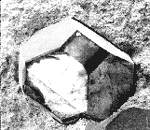
A
B |
| Figure 5: A coated diamond crystal with no graphitization (A) compared to an uncoated diamond crystal with severe edge loss (B). |
A thin metallic coating or surface treatment shields the diamond from direct contact with the metal and preserves the cutting integrity of the diamond crystal while still providing a strong bond between the crystal and the matrix. Depending on the metal matrix material, the coating may be titanium or chromium. Figure 5 shows the benefits of applying these coatings to diamond crystals in a metal bond. The coated crystal shows no signs of adverse graphitization, while the uncoated crystal shows signs of severe reaction and the loss of cutting edges and corners.
Superabrasive coatings serve a similar function in vitrified-bond grinding wheels, where they help control potentially harmful chemical reactions between the crystal and the vitrified matrix.
Vitrified Bonds
Vitrified bonds are rapidly becoming the most popular type of matrix for CBN grinding wheels. They are finding greater acceptance in diamond wheels as well. Vitrified bonds combine the characteristics of both resin bonds and metal bonds to provide fast and cool cutting action and high resistance to wear. The extremely strong, glass-like bond requires less matrix material than resin or metal bonds do to hold the superabrasive crystals securely, and vitrified-bond wheels have a higher bonding strength.
Matrix porosity levels are typically in the range of 10% to 25% in vitrified-bond wheels, compared to less than 2% in most resin- and metal-bond wheels. This porosity allows space for chip formation and coolant flow. Induced-porosity levels of as much as 20% to 30% are common in vitrified-bond CBN grinding wheels.
This high porosity allows single-step conditioning of vitrified-bond grinding wheels. Both resin- and metal-bond wheels require a two-step wheel-conditioning process. These wheels first must be trued to impart the proper geometry to the working surface. The wheels then must be dressed to expose the superabrasive crystals. This is done by removing matrix material from around the crystals. In the highly porous matrix of vitrified-bond wheels, the crystals are already exposed after truing.
Vitrified bonds have unique advantages over the other bond types, but they also have unique problems, particularly when they are combined with CBN crystals. At the high temperatures generated during wheel manufacture, a chemical reaction that bonds the crystals to the matrix material may occur. A controlled reaction reduces premature loss of the crystal. A severe reaction, however, can cause gasing and the formation of minute bubbles (similar to foam) around the CBN crystals. This foam weakens the bond, resulting in shorter wheel life and poor overall performance.
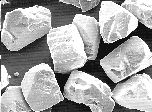
A
B |
| Figure 6: Uncoated (A) and titanium-coated (B) CBN crystals used in vitrified bonds. |
Some manufacturers of vitrified-bond CBN grinding wheels have found that superabrasive coatings can be used to control and moderate this chemical reaction. For these wheels, however, the coatings are not as thick as those used for resin-bond wheels. A thick coating cannot be applied to CBN crystals in vitrified-bond wheels, because the large differences in the coefficients of thermal expansion between the coating, the crystal, and the matrix material would be detrimental to the wheel-fabrication process. Instead, a thin metallic surface treatment is applied that leaves a chemically bonded layer of metal only 1µm thick (Figure 6).
Titanium is typically used for this superabrasive coating. When this metal is applied to a CBN crystal, it forms titanium nitrides and titanium diborides at the crystal/coating interface. The titanium, which is already bonded to the CBN crystal, chemically bonds to the vitrified matrix and forms a strong crystal/matrix bond. Titanium coatings also can optimize the performance of many single-layer grinding wheels.
No Bonds
Single-layer grinding wheels are not considered bonded products, because the layer of superabrasive crystals is not fully encapsulated in the matrix. Most single-layer wheels are composed of crystals that have been attached to the surface of a steel wheel core by a layer of nickel through an electroplating process. The finished wheel has a layer of bare crystals held in place by a layer of nickel. The thickness of this nickel layer is approximately one-third to one-half the diameter of the crystal. For example, a crystal with a 60/80 mesh size can have a nickel-plated layer between 100µm and 125µm thick.
For this method of wheel manufacture, the superabrasive crystal must have a clean surface to ensure uniform mechanical adhesion, and it must be electrically nonconductive. If the crystal were coated with most metallic and nonmetallic coating materials, the electroplating process would result in total encapsulation of the crystals and a dramatic reduction in wheel performance. Therefore, electroplated wheels typically have uncoated superabrasive crystals.
Another method of manufacturing single-layer grinding wheels incorporates a brazing process to attach the superabrasive crystals to the wheel core. In this process, it is essential to wet the crystals with the braze metal to develop a strong bond. The thickness of the braze layer is typically between 15% and 30% of the crystal diameter. A crystal with a 60/80 mesh size can have a braze layer between 40µm and 75µm thick.
Since the braze layer is relatively thin, the strength of its bond with the diamond or CBN crystal is critical. Titanium and chromium coatings that are chemically bonded to the superabrasive crystals have proven to be beneficial in the wetting and bonding process.
The Future
The selection of a superabrasive grinding wheel with coated crystals or one with uncoated crystals depends on the requirements of the particular application. The majority of vitrified-bond and single-layer wheels have uncoated superabrasive crystals for applications such as ID grinding of bearings, cylindrical grinding of camlobes and crankpins, involute grinding of gear teeth, and form grinding of cutting tools and aerospace components. Resin-bond wheels with uncoated superabrasive crystals are generally used for the polishing of metals (steel, silicon carbide, cast iron) and nonmetallic materials (glass, ceramics, tungsten carbide). They are also used in some dry grinding applications to minimize grinding power, but at the expense of wheel life.
A wheel with coated crystals generally costs 2% to 20% more than one with uncoated crystals; however, it lasts two to three times longer. Currently, between one-fourth and one-third of all CBN and manufactured diamond is customized for applications through some type of surface modification, whether it be a coating or another surface treatment. As demands on superabrasive-wheel performance continue to increase, coatings and other surface treatments will play an even greater role in wheel design and development. For the best wheel performance, bond systems must be formulated to take advantage of the variety of coatings and surface treatments available. Only when the combination of superabrasive coatings and bond systems is optimized will superabrasive grinding wheels offer maximum performance and cost-effectiveness.
About the Author
Alan Carius is manager of the Borazon CBN programs at GE Superabrasives, Worthington, OH.
Related Glossary Terms
- ceramics
ceramics
Cutting tool materials based on aluminum oxide and silicon nitride. Ceramic tools can withstand higher cutting speeds than cemented carbide tools when machining hardened steels, cast irons and high-temperature alloys.
- coolant
coolant
Fluid that reduces temperature buildup at the tool/workpiece interface during machining. Normally takes the form of a liquid such as soluble or chemical mixtures (semisynthetic, synthetic) but can be pressurized air or other gas. Because of water’s ability to absorb great quantities of heat, it is widely used as a coolant and vehicle for various cutting compounds, with the water-to-compound ratio varying with the machining task. See cutting fluid; semisynthetic cutting fluid; soluble-oil cutting fluid; synthetic cutting fluid.
- creep-feed grinding
creep-feed grinding
Grinding operation in which the grinding wheel is slowly fed into the workpiece at sufficient depth of cut to accomplish in one pass what otherwise would require repeated passes. See grinding.
- cubic boron nitride ( CBN)
cubic boron nitride ( CBN)
Crystal manufactured from boron nitride under high pressure and temperature. Used to cut hard-to-machine ferrous and nickel-base materials up to 70 HRC. Second hardest material after diamond. See superabrasive tools.
- cubic boron nitride ( CBN)2
cubic boron nitride ( CBN)
Crystal manufactured from boron nitride under high pressure and temperature. Used to cut hard-to-machine ferrous and nickel-base materials up to 70 HRC. Second hardest material after diamond. See superabrasive tools.
- cutoff
cutoff
Step that prepares a slug, blank or other workpiece for machining or other processing by separating it from the original stock. Performed on lathes, chucking machines, automatic screw machines and other turning machines. Also performed on milling machines, machining centers with slitting saws and sawing machines with cold (circular) saws, hacksaws, bandsaws or abrasive cutoff saws. See saw, sawing machine; turning.
- cylindrical grinding
cylindrical grinding
Grinding operation in which the workpiece is rotated around a fixed axis while the grinding wheel is fed into the outside surface in controlled relation to the axis of rotation. The workpiece is usually cylindrical, but it may be tapered or curvilinear in profile. See centerless grinding; grinding.
- grinding
grinding
Machining operation in which material is removed from the workpiece by a powered abrasive wheel, stone, belt, paste, sheet, compound, slurry, etc. Takes various forms: surface grinding (creates flat and/or squared surfaces); cylindrical grinding (for external cylindrical and tapered shapes, fillets, undercuts, etc.); centerless grinding; chamfering; thread and form grinding; tool and cutter grinding; offhand grinding; lapping and polishing (grinding with extremely fine grits to create ultrasmooth surfaces); honing; and disc grinding.
- grinding wheel
grinding wheel
Wheel formed from abrasive material mixed in a suitable matrix. Takes a variety of shapes but falls into two basic categories: one that cuts on its periphery, as in reciprocating grinding, and one that cuts on its side or face, as in tool and cutter grinding.
- hardness
hardness
Hardness is a measure of the resistance of a material to surface indentation or abrasion. There is no absolute scale for hardness. In order to express hardness quantitatively, each type of test has its own scale, which defines hardness. Indentation hardness obtained through static methods is measured by Brinell, Rockwell, Vickers and Knoop tests. Hardness without indentation is measured by a dynamic method, known as the Scleroscope test.
- inner diameter ( ID)
inner diameter ( ID)
Dimension that defines the inside diameter of a cavity or hole. See OD, outer diameter.
- polishing
polishing
Abrasive process that improves surface finish and blends contours. Abrasive particles attached to a flexible backing abrade the workpiece.
- surface texture
surface texture
Repetitive or random deviations from the nominal surface, which form 3-D topography of the surface. See flows; lay; roughness; waviness.
- truing
truing
Using a diamond or other dressing tool to ensure that a grinding wheel is round and concentric and will not vibrate at required speeds. Weights also are used to balance the wheel. Also performed to impart a contour to the wheel’s face. See dressing.

